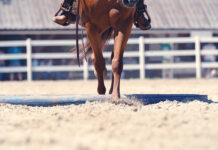
- Don’t assume that your regular fly repellent will safeguard you or your horse from stinging insects. Standard repellents will not deter an angry bee or wasp if you disturb a nest.
- While riding or working around your horse, don’t wear perfume, cologne, scented deodorant or soaps that might attract insects.
- If you accidentally disturb a bee, wasp or hornet nest while out riding, the best thing to do is move out of the area as swiftly as possible. Bees can obtain speeds up to 15 miles per hour, but you and your horse should easily be able to outrun them. If you’ve disturbed a hive of Africanized honeybees, keep running! These ornery bees have been known to continue an attack as far as a quarter of a mile.
- Keep barn trash containers neat and tidy and away from grooming and saddling areas. Don’t leave cans of open soda pop where insects might be drawn to them. Place open drinks in a cooler or the barn refrigerator while you work with your horse.
- Set wasp traps around your barn and property, but avoid putting traps in high-use zones, such as tacking and grooming areas.
- Keep your barn well swept of spider webs, being sure to check in dark corners and rafters. Automatic barn misters for fly control will also help reduce spider infestations in your barn.
- If you live in snake country, keep horse feed in mouse- and rat-proof bins, and be sure to clean up any spilled feed that might attract these vermin. You can expect snakes to move in if you have a problem with mice.
- Clean up the junk around your barn, and always use caution when reaching into dark places—snakes like to sleep under rocks, piles of jump poles, stored hay, et cetera.
- Non-venomous snakes are beneficial to have around. Black racer, milk and kingsnakes not only help control barn rats and mice, they also eat other snakes, including their venomous cousins.
- While riding watch the trail well ahead of your horse. If you see a snake in the trail, stop and wait for it to move off the trail before proceeding or find a way to avoid it.
- Leave snakes alone. Most people are bitten while trying to get a closer look at the snake or trying to kill it.
- When riding in snake country, stay on the open trail rather than areas of tall grass and over brush-covered logs that might easily conceal a snake. If you do surprise a snake, move away as slowly and calmly as possible—avoid sudden movements that might provoke it to strike.
- Venomous snakes like the cottonmouth reside near bodies of water, such as streams, creeks and ponds. Keep an eye out for snakes as you approach a water crossing or before allowing your horse to drink.






I prefer to spray raid on any nest I find, that way the little pests don’t stand a chance of getting near me or my horse. I would like to also know why there can be more butterflies and humming birds to pollinate flowers, I hate bees,
wasps, hornets and everything else that buzzes and/or has a stinger.
Just a comment…..AS we all hate wasps and hornets, we must remember that bees are extremely beneficial to our very existence! STOP SPRAYING THEM! We have to remember that no bees…no humans..it really is that simple. (Repeating because I had entered my email incorrectly.)